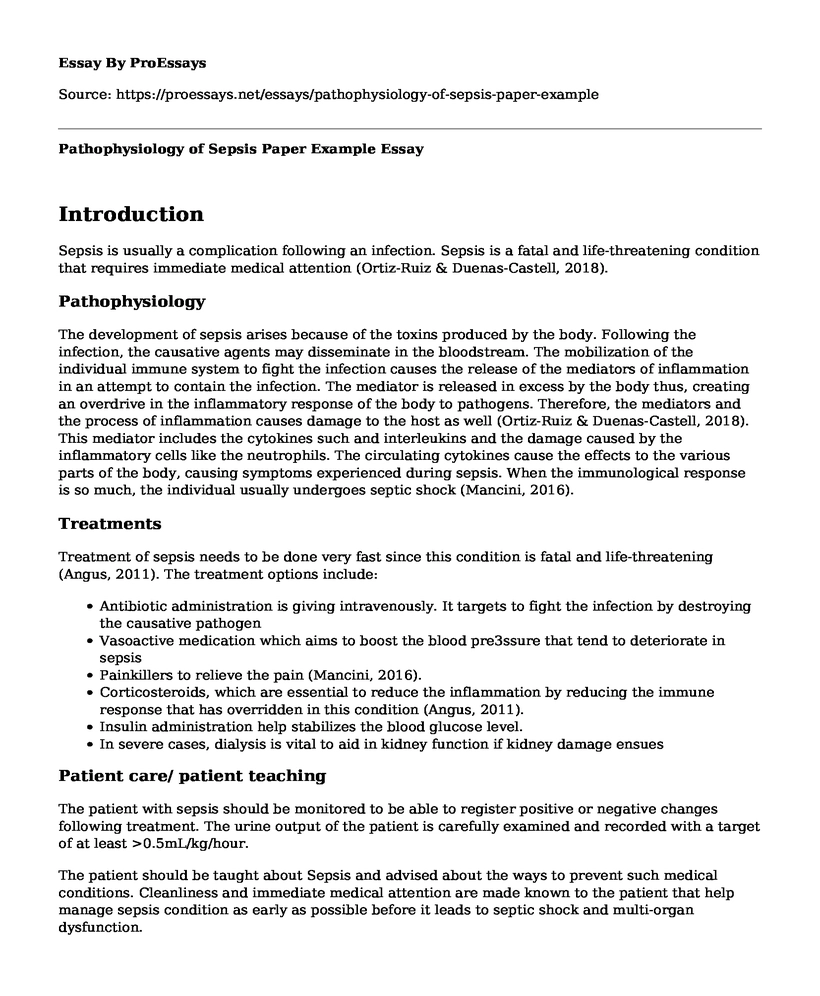Introduction
Sepsis is usually a complication following an infection. Sepsis is a fatal and life-threatening condition that requires immediate medical attention (Ortiz-Ruiz & Duenas-Castell, 2018).
Pathophysiology
The development of sepsis arises because of the toxins produced by the body. Following the infection, the causative agents may disseminate in the bloodstream. The mobilization of the individual immune system to fight the infection causes the release of the mediators of inflammation in an attempt to contain the infection. The mediator is released in excess by the body thus, creating an overdrive in the inflammatory response of the body to pathogens. Therefore, the mediators and the process of inflammation causes damage to the host as well (Ortiz-Ruiz & Duenas-Castell, 2018). This mediator includes the cytokines such and interleukins and the damage caused by the inflammatory cells like the neutrophils. The circulating cytokines cause the effects to the various parts of the body, causing symptoms experienced during sepsis. When the immunological response is so much, the individual usually undergoes septic shock (Mancini, 2016).
Treatments
Treatment of sepsis needs to be done very fast since this condition is fatal and life-threatening (Angus, 2011). The treatment options include:
- Antibiotic administration is giving intravenously. It targets to fight the infection by destroying the causative pathogen
- Vasoactive medication which aims to boost the blood pre3ssure that tend to deteriorate in sepsis
- Painkillers to relieve the pain (Mancini, 2016).
- Corticosteroids, which are essential to reduce the inflammation by reducing the immune response that has overridden in this condition (Angus, 2011).
- Insulin administration help stabilizes the blood glucose level.
- In severe cases, dialysis is vital to aid in kidney function if kidney damage ensues
Patient care/ patient teaching
The patient with sepsis should be monitored to be able to register positive or negative changes following treatment. The urine output of the patient is carefully examined and recorded with a target of at least >0.5mL/kg/hour.
The patient should be taught about Sepsis and advised about the ways to prevent such medical conditions. Cleanliness and immediate medical attention are made known to the patient that help manage sepsis condition as early as possible before it leads to septic shock and multi-organ dysfunction.
Diagnostic Tests
The diagnosis of the sepsis is essential to go for the drugs that are sensitive to the identified infection. The diagnostic test includes:
1. Blood culture tests- usually taken before antibiotic administration. It is where the causative agents are grown and determined. From the culture, several tests are essential to help identify the causative agents such as gram stain, catalase test, coagulase test, IMVIC test, and many others that help define the causative agent of infection. Culture also allows the drug sensitivity to narrow down to effective drugs for the disease (Mancini, 2016).
2. Urinalysis and electrolytes determination
3. Imaging techniques such as x rays and MRI
4. Liver function tests- They are usually abnormal results (Mancini, 2016).
5. Full blood count in the blood sample
6. Urine culture or another specimen like a swab, abscess
References
Angus, D. (2011). Management of Sepsis. JAMA, 305(14), 1469. doi: 10.1001/jama.2011.438
Mancini, N. (2016). Sepsis. [Place of publication not identified]: Humana.
Ortiz-Ruiz, G., & Duenas-Castell, C. (2018). Sepsis. New York, NY: Springer New York.
Cite this page
Pathophysiology of Sepsis Paper Example. (2022, Jul 25). Retrieved from https://proessays.net/essays/pathophysiology-of-sepsis-paper-example
If you are the original author of this essay and no longer wish to have it published on the ProEssays website, please click below to request its removal:
- Essay Sample on Electronic Healthcare System in Norway
- Ectopic Pregnancy: Effects, Risks, & Prevention - Research Paper
- Zika Virus: Mosquito-Borne Threat to People - Essay Sample
- Essay Sample on Partnering with Alabama Public Health Districts: Health & Community Benefits
- Rising Diabetes: Treatment Needed to Prevent Complications & Death - Research Paper
- Essay Sample on COVID-19 Pandemic: Causes, Clinical Presentations & Impact
- Suicide Rates - Report Example







